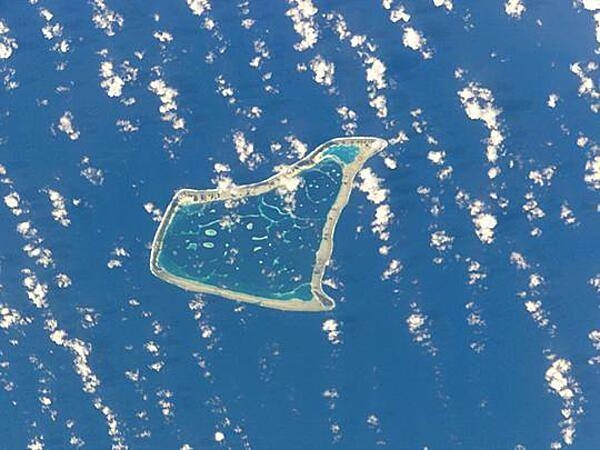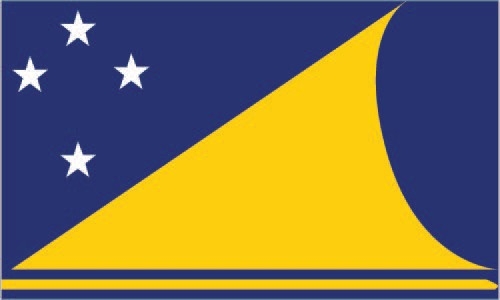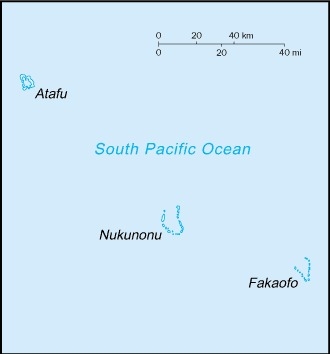Introduction
Background
Tokelau, which comprises three atolls, was first settled by Polynesians around A.D. 1000. The three atolls operated relatively independently but had contact with one another, intermarrying and occasionally fighting wars. Fakaofo Atoll eventually subjugated the other two. British explorer John BYRON was the first European to see Atafu Atoll in 1765. British naval officer Edward EDWARDS saw Nukunonu Atoll in 1791, and ships occasionally continued to pass by Atafu and Nukunonu. In 1835, a US whaling ship became the first non-Pacific island ship to pass by Fakaofo. Catholic and Protestant missionaries arrived in 1845 and converted the population on the islands on which they landed. To this day, Nukunonu is predominantly Catholic while Atafu is mostly Protestant; Catholic and Protestnat missionaries both worked in Fakaofo, and the population there is more mixed.
In 1863, Peruvian slave traders, masquerading as missionaries, kidnapped nearly all the men from Tokelau, and local governance moved to a system based on a Council of Elders, which still exists today. The atolls were repopulated when new Polynesian settlers and American and European migrants intermarried with local Tokelauan women. Tokelau became a British protectorate in 1889 and included in the Gilbert and Ellice Islands Protectorate - later a colony - in 1908. In 1925, the UK placed Tokealu under New Zealand administration. The Tokelau Islands Act of 1948 formally transferred sovereignty from the UK to New Zealand and Tokelauans were granted New Zealand citizenship. In 1979, the US relinquished its claims over Tokelau in the Treaty of Tokehega, and Tokelau relinquished its claims over Swains Island, which is part of American Samoa.
Economic opportunities in Tokelau are sparse, and about 80% of Tokelauans live in New Zealand. Tokelau held two self-governance referendums in 2006 and 2007, in which more than 60% of voters chose to go into free association with New Zealand; however, the referendums failed to achieve the two-thirds majority necessary to enact a status change. Tokelau lacks an airport and is only accessible via a day-long boat trip from Samoa, although a site for an airstrip on Nukunonu was selected in 2019. Because of its dependency on Samoa for transportation, in 2011, Tokelau followed Samoa’s lead and shifted the international date line to its east, skipping December 30 and becoming one hour ahead of New Zealand rather than 23 hours behind.
Visit the Definitions and Notes page to view a description of each topic.
Geography
Location
Oceania, group of three atolls in the South Pacific Ocean, about one-half of the way from Hawaii to New Zealand
Geographic coordinates
9 00 S, 172 00 W
Map references
Oceania
Area - comparative
about 17 times the size of the National Mall in Washington, DC
Land boundaries
total: 0 km
Coastline
101 km
Maritime claims
territorial sea: 12 nm
exclusive economic zone: 200 nm
Climate
tropical; moderated by trade winds (April to November)
Terrain
low-lying coral atolls enclosing large lagoons
Elevation
highest point: unnamed location 5 m
lowest point: Pacific Ocean 0 m
Land use
agricultural land: 60% (2018 est.)
arable land: 0% (2018 est.)
permanent crops: 60% (2018 est.)
permanent pasture: 0% (2018 est.)
forest: 0% (2018 est.)
other: 40% (2018 est.)
Irrigated land
0 sq km (2012)
Population distribution
the country's small population is fairly evenly distributed amongst the three atolls
Natural hazards
lies in Pacific cyclone belt
Geography - note
consists of three atolls (Atafu, Fakaofo, Nukunonu), each with a lagoon surrounded by a number of reef-bound islets of varying length and rising to over 3 m above sea level
People and Society
Nationality
noun: Tokelauan(s)
adjective: Tokelauan
Ethnic groups
Tokelauan 64.5%, part Tokelauan/Samoan 9.7%, part Tokelauan/Tuvaluan 2.8%, Tuvaluan 7.5%, Samoan 5.8%, other Pacific Islander 3.4%, other 5.6%, unspecified 0.8% (2016 est.)
Languages
Tokelauan 88.1% (a Polynesian language), English 48.6%, Samoan 26.7%, Tuvaluan 11.2%, Kiribati 1.5%, other 2.8%, none 2.8%, unspecified 0.8% (2016 ests.)
note: shares sum to more than 100% because some respondents gave more than one answer on the census
Religions
Congregational Christian Church 50.4%, Roman Catholic 38.7%, Presbyterian 5.9%, other Christian 4.2%, unspecified 0.8% (2016 est.)
Age structure
0-14 years: NA
15-24 years: NA
25-54 years: NA
55-64 years: NA
65 years and over: NA
Dependency ratios
total dependency ratio: NA
youth dependency ratio: NA
elderly dependency ratio: NA
potential support ratio: NA
Population distribution
the country's small population is fairly evenly distributed amongst the three atolls
Urbanization
urban population: 0% of total population (2021)
rate of urbanization: 0% annual rate of change (2020-25 est.)
Infant mortality rate
total: NA
male: NA
female: NA (2021 est.)
Life expectancy at birth
total population: NA
male: NA
female: NA (2021 est.)
Total fertility rate
NA (2021 est.)
Drinking water source
improved: rural: 100% of population
total: 100% of population
unimproved: rural: 0% of population
total: 0% of population (2017 est.)
Physicians density
2.72 physicians/1,000 population (2010)
Sanitation facility access
improved: rural: 100% of population
total: 100% of population
unimproved: rural: 0% of population
total: 0% of population (2017 est.)
Major infectious diseases
degree of risk: high (2020)
food or waterborne diseases: bacterial diarrhea
vectorborne diseases: malaria
Environment
Environment - current issues
overexploitation of certain fish and other marine species, coastal sand, and forest resources; pollution of freshwater lenses and coastal waters from improper disposal of chemicals
Climate
tropical; moderated by trade winds (April to November)
Land use
agricultural land: 60% (2018 est.)
arable land: 0% (2018 est.)
permanent crops: 60% (2018 est.)
permanent pasture: 0% (2018 est.)
forest: 0% (2018 est.)
other: 40% (2018 est.)
Urbanization
urban population: 0% of total population (2021)
rate of urbanization: 0% annual rate of change (2020-25 est.)
Major infectious diseases
degree of risk: high (2020)
food or waterborne diseases: bacterial diarrhea
vectorborne diseases: malaria
Total renewable water resources
0 cubic meters (2017 est.)
Government
Country name
conventional long form: none
conventional short form: Tokelau
former: Union Islands, Tokelau Islands
etymology: "tokelau" is a Polynesian word meaning "north wind"
Government type
parliamentary democracy under a constitutional monarchy
Dependency status
self-administering territory of New Zealand; note - Tokelau and New Zealand have agreed to a draft constitution as Tokelau moves toward free association with New Zealand; a UN-sponsored referendum on self governance in October 2007 did not meet the two-thirds majority vote necessary for changing the political status
Capital
time difference: UTC+13 (18 hours ahead of Washington, DC during Standard Time)
note: there is no designated, official capital for Tokelau; the location of the capital rotates among the three atolls along with the head of government or Ulu o Tokelau
Administrative divisions
none (territory of New Zealand)
Independence
none (territory of New Zealand)
National holiday
Waitangi Day (Treaty of Waitangi established British sovereignty over New Zealand), 6 February (1840)
Constitution
history: many previous; latest effective 1 January 1949 (Tokelau Islands Act 1948)
amendments: proposed as a resolution by the General Fono; passage requires support by each village and approval by the General Fono; amended several times, last in 2007
Legal system
common law system of New Zealand
Citizenship
see New Zealand
Suffrage
21 years of age; universal
Executive branch
chief of state: Queen ELIZABETH II (since 6 February 1952); represented by Governor General of New Zealand Governor General Dame Patricia Lee REDDY (since 28 September 2016); New Zealand is represented by Administrator Ross ARDERN (since May 2018)
head of government: (Ulu o Tokelau) Kelihiano KALOLO (since 8 March 2021); note - position rotates annually among the three Faipule (village leaders) of the atolls
cabinet: Council for the Ongoing Government of Tokelau (or Tokelau Council) functions as a cabinet; consists of 3 Faipule (village leaders) and 3 Pulenuku (village mayors)
elections/appointments: the monarchy is hereditary; governor general appointed by the monarch; administrator appointed by the Minister of Foreign Affairs and Trade in New Zealand; head of government chosen from the Council of Faipule to serve a 1-year term
note: the meeting place of the Tokelau Council rotates annually among the three atolls; this tradition has given rise to the somewhat misleading description that the capital rotates yearly between the three atolls; in actuality, it is the seat of the government councilors that rotates since Tokelau has no capital
Legislative branch
description: unicameral General Fono (20 seats apportioned by island - Atafu 7, Fakaofo 7, Nukunonu 6; members directly elected by simple majority vote to serve 3-year terms); note - the Tokelau Amendment Act of 1996 confers limited legislative power to the General Fono
elections: last held on 23 January 2020 depending on island (next to be held in January 2023)
election results: percent of vote by party - NA; seats by party - independent 20; composition - men 17, women 3, percent of women 15%
Judicial branch
highest courts: Court of Appeal (in New Zealand) (consists of the court president and 8 judges sitting in 3- or 5-judge panels, depending on the case)
judge selection and term of office: judges nominated by the Judicial Selection Committee and approved by three-quarters majority of the Parliament; judges serve for life
subordinate courts: High Court (in New Zealand); Council of Elders or Taupulega
International organization participation
PIF (associate member), SPC, UNESCO (associate), UPU
Diplomatic representation in the US
none (territory of New Zealand)
Diplomatic representation from the US
none (territory of New Zealand)
Flag description
a yellow stylized Tokelauan canoe on a dark blue field sails toward the manu - the Southern Cross constellation of four, white, five-pointed stars at the hoist side; the Southern Cross represents the role of Christianity in Tokelauan culture and, in conjunction with the canoe, symbolizes the country navigating into the future; the color yellow indicates happiness and peace, and the blue field represents the ocean on which the community relies
National symbol(s)
tuluma (fishing tackle box); national colors: blue, yellow, white
National anthem
name: "Te Atua" (For the Almighty)
lyrics/music: unknown/Falani KALOLO
note: adopted 2008; in preparation for eventual self governance, Tokelau held a national contest to choose an anthem; as a territory of New Zealand, "God Defend New Zealand" and "God Save the Queen" are official (see New Zealand)
Economy
Economic overview
Tokelau's small size (three villages), isolation, and lack of resources greatly restrain economic development and confine agriculture to the subsistence level. The principal sources of revenue are from sales of copra, postage stamps, souvenir coins, and handicrafts. Money is also remitted to families from relatives in New Zealand.
The people rely heavily on aid from New Zealand - about $15 million annually in FY12/13 and FY13/14 - to maintain public services. New Zealand's support amounts to 80% of Tokelau's recurrent government budget. An international trust fund, currently worth nearly $32 million, was established in 2004 by New Zealand to provide Tokelau an independent source of revenue.
Real GDP (purchasing power parity)
$7,711,583 (2017 est.)
note: data are in 2017 dollars.
Real GDP per capita
$6,004 (2017 est.)
$4,855 (2016 est.)
$4,292 (2015 est.)
note: data are in 2017 dollars.
GDP (official exchange rate)
$12.658 million (2017 est.)
note: data uses New Zealand Dollar (NZD) as the currency of exchange.
Inflation rate (consumer prices)
4% (2020 est.)
2.5% (2019 est.)
11% (2017 est.)
note: Tokelau notes that its wide inflation swings are due almost entirely due to cigarette prices, a chief import.
GDP - composition, by sector of origin
agriculture: NA
industry: NA
services: NA
Agricultural products
coconuts, roots/tubers nes, tropical fruit, pork, bananas, eggs, poultry, pig offals, pig fat, fruit
Industries
small-scale enterprises for copra production, woodworking, plaited craft goods; stamps, coins; fishing
Unemployment rate
2% (2015 est.)
note: Underemployment may be as high as 6.6%
Budget
revenues: 24,324,473 (2017 est.)
expenditures: 11,666,542 (2017 est.)
Fiscal year
1 April - 31 March
Exports - partners
Singapore 25%, France 19%, South Africa 7%, New Zealand 5%, United States 5%, Ireland 5% (2019)
Exports - commodities
oscilloscopes, house linens, fruits, nuts, recreational boats, iron products (2019)
Imports - partners
Samoa 35%, Ireland 17%, Philippines 14%, Malaysia 13%, South Africa 9% (2019)
Imports - commodities
oscilloscopes, integrated circuits, refined petroleum, packaged medicines, orthopedic appliances (2019)
Exchange rates
New Zealand dollars (NZD) per US dollar -
1.543 (2017 est.)
Energy
Communications
Telephones - fixed lines
total subscriptions: 0 (2018 est.)
subscriptions per 100 inhabitants: 0 (2018 est.)
Telecommunication systems
general assessment: modern satellite-based communications system; demand for mobile broadband increasing due to mobile services being the method of access for Internet across the region; 2G widespread with some 4G LTE service; satellite services has improved with the launch of the Kacific-1 satellite launched in 2019 (2020)
domestic: radiotelephone service between islands; fixed-line 21 per 100 persons (2019)
international: country code - 690; landing point for the Southern Cross NEXT submarine cable linking Australia, Tokelau, Samoa, Kiribati, Fiji, New Zealand and Los Angeles, CA (USA); radiotelephone service to Samoa; government-regulated telephone service (TeleTok); satellite earth stations - 3 (2020)
note: the COVID-19 pandemic continues to have a significant impact on production and supply chains globally; since 2020, some aspects of the telecom sector have experienced downturn, particularly in mobile device production; many network operators delayed upgrades to infrastructure; progress towards 5G implementation was postponed or slowed in some countries; consumer spending on telecom services and devices was affected by large-scale job losses and the consequent restriction on disposable incomes; the crucial nature of telecom services as a tool for work and school from home became evident, and received some support from governments
Broadcast media
Sky TV access for around 30% of the population; each atoll operates a radio service that provides shipping news and weather reports (2019)
Internet users
total: 818 (2021 est.)
percent of population: 60.2% (July 2016 est.)
Transportation
Ports and terminals
none; offshore anchorage only
Military and Security
Military - note
defense is the responsibility of New Zealand
Transnational Issues
Disputes - international
Tokelau included American Samoa's Swains Island (Olosega) in its 2006 draft independence constitution



